If you’re just starting out with chickens and aren’t sure which breeds to choose, the Plymouth Rock is a must-have.
When it comes to chickens, the Plymouth Rock is a tried-and-true classic. Many people across the country have a soft spot in their hearts for this chicken because it represents one of the original breeds developed in the United States.
Besides being a fantastic pet and a reliable source of eggs, this hen also makes a delicious addition to the dinner table.
Keep reading as we cover all the basics of Plymouth Rock chickens, from the different strains to their egg production and how to keep them healthy and happy.
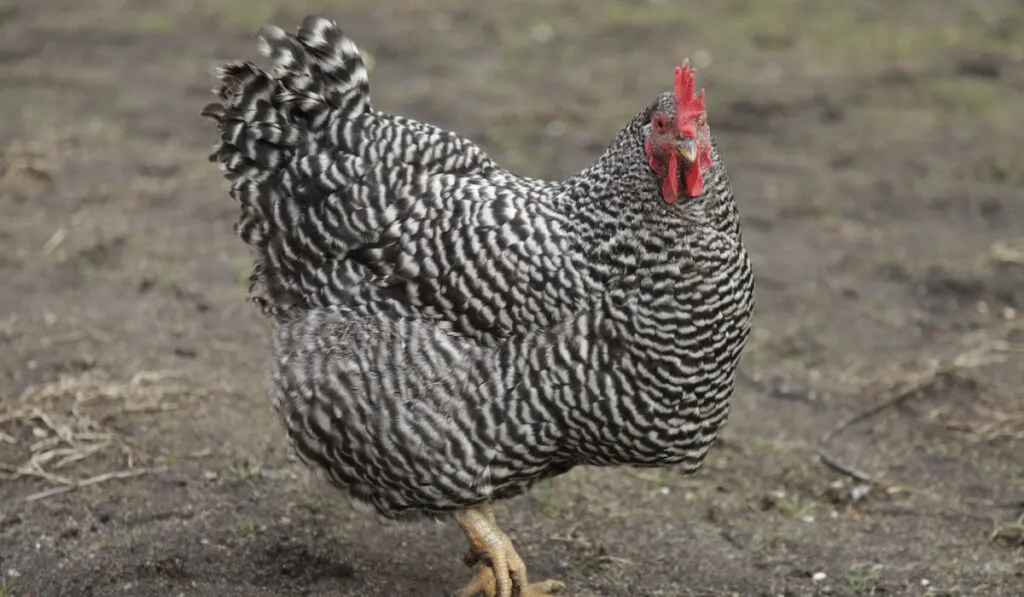
Table of Contents
Plymouth Rock Chicken Key Information
| Male Weight: | 9.5 lbs |
| Female Weight: | 7 lbs |
| Use: | Dual-purpose chickens, for both meat and eggs |
| Egg Size: | Large |
| Egg Production: | Up to 280 per year |
| Lifespan: | Average 6 – 8 years |
| Climate Tolerance: | Good heat tolerance and excellent cold tolerance |
| Color: | Black and white |
| Temperament: | Docile, friendly nature |
| Flying Ability: | Poor |
| Beginner friendly: | Yes |
Plymouth Rock Chicken Origins
In the United States, the Plymouth Rock is among the oldest domestic breeds.
The Plymouth Rock chicken was created in the United States in the nineteenth century and was first shown publicly as a breed in Boston in 1849.
Twenty years passed before the breed was seen again at a poultry show in 1869 when a Mr. Upham from Massachusetts had crossed some barred roosters with Java hens.
In 1874, the breed was officially included in the American Poultry Association’s Standard of Excellence. These birds are the ancestors of today’s Plymouth Rocks.
Due to its robustness, docility, broodiness, good egg production, and tasty and juicy meat, it quickly became a famous farm bird.
But this bird was praised by more than just farmers.
The Plymouth Rock chicken was a classic example of a breed that helped launch the modern broiler business in the 1920s.
Before World War II, no breed had ever been housed and bred to such an extent as the Plymouth Rock. By the beginning of the modern industrial age, the Rock’s once-great fame had declined.
When new varieties of chickens were developed, they displaced Plymouth Rocks in terms of popularity. As a result, for many years, the breed went downhill.
But now that people are more aware of organic living and don’t want to eat industrially raised food, Plymouth Rock chickens are becoming popular again among small homesteaders and backyard chicken keepers.
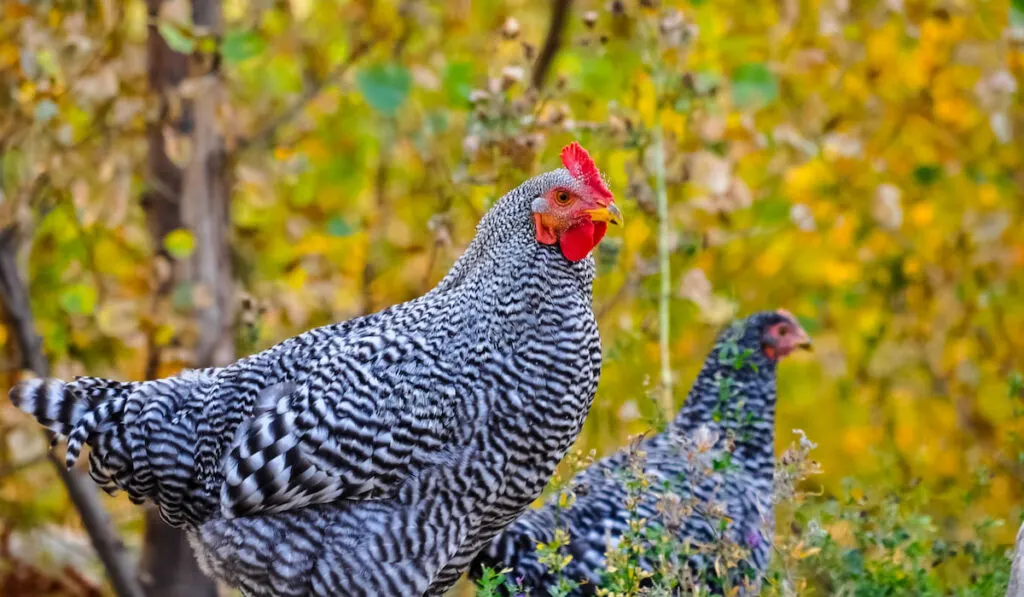
Varieties of Plymouth Rock
In 1874, the Barred Plymouth Rock chicken breed was officially recognized by the American Poultry Association. Today, seven distinct types are recognized.
However, when people refer to a “Rock chicken,” they almost certainly mean the Barred Plymouth Rock type.
Most of the other varieties are pretty rare. They are:
- White
- Buff
- Buff Columbian
- Columbian
- Silver Partridge
- Blue Laced
Only five types are officially recognized by the Poultry Club of Great Britain, although the European Association of Poultry counts ten.
This article will focus on the Barred Plymouth Rock, the USA’s most common and oldest chicken breed.
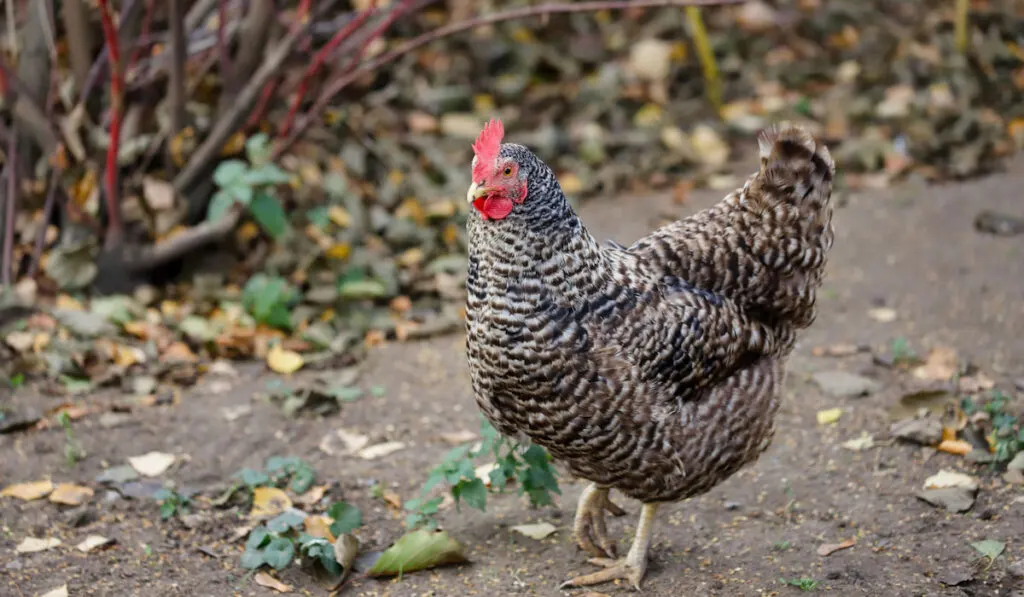
Feathers of a Plymouth Rock Chicken
The feathers of a Plymouth Rock chicken are long enough to be puffy and fluffy, especially around the belly, yet short enough to avoid becoming tangled.
The Plymouth Rock Chicken comes in a range of colors.
The most common is the Barred Rock Chicken, which has a striking black and white barred pattern. This striped pattern is caused by a dominant gene that is linked to sex.
This gene doesn’t make dark bars on light feathers, but it stops white pigment from forming on dark feathers.
Males are often paler than females because they have two copies of the gene, whereas females only have one. Because of this, the bars for male and female birds are a little different.
The rooster’s bars are all the same width, while the black bars on the hens are wider than the white ones.
Body type
A Plymouth Rock chicken is a big, sturdy bird.
The Plymouth Rock body, which resembles a triangle, is solid and stout due to its broad chest and long, broad back.
The hens have full, deep bellies, which signifies that they lay well.
Size
A standard-sized:
Rooster: 9.5 lbs
Hen: 7.5 lbs
Bantam variety:
Rooster: 3 lbs
Hen: 2.5 lbs

Other Appearance Features
The skin of a Plymouth Rock chicken’s legs is bright yellow. They have long, clean legs and four toes on each foot.
The Plymouth Rock chicken’s eyes are a crimson bay, and the beak is a bright yellow.
Their one and only comb is straight and has five points. The earlobes, comb, and wattles, in addition to the face, should all be bright red.
The entire coloration of the bird—white, black, and red—is stunning and elegant.
Plymouth Rock – A Source of Eggs
These Plymouth Rock chickens really shine as layer hens.
A hen typically lays about 200 eggs per year, which equates to about four eggs per week from a single hen.
Even during the colder winter months, Plymouth Rock hens continue to lay eggs regularly.
Their eggs are large and come in a variety of light brown tones.
While some people believe that brown eggs have a superior flavor, others firmly believe white eggs are the way to go. But most of us wouldn’t be able to tell the difference.
The nutrition of brown and white-shelled eggs is the same, though. But what the hens eat and where they live can greatly affect how healthy their eggs are.
While Plymouth Rocks hens have a high egg production rate for the first two years of their lives, that rate tends to drop slowly by the third year.
But there have been cases of chickens still laying eggs at ten years of age!

Plymouth Rock – A Meat Source
Before World War II, practically all of America’s chicken meat came from Plymouth Rocks because of their high rate of meat production.
Within 8–12 weeks, the chicks have grown and developed enough to be termed “broilers.” A broiler is a chicken that is bred and raised to be used for meat.
However, if you want to maximize your meat yield, you may let them develop until they are 7 or 8 months old before slaughtering.
The golden, juicy flesh of a Plymouth Rock makes it a great choice for a roast.
After 9–10 months, your bird’s meat will no longer be as delicate and tender, so the best use at that point will be for stewing or making chicken stock.
Plymouth Rock – A Helper in Your Garden
In their natural habitat, Plymouth Rock chickens engage in scratching and foraging.
These chickens enjoy working in the garden with their human companions. They will have a blast helping you clean up your garden by scratching weeds and eating pests.
You can also use their poop as a great natural ingredient to obtain nutrient-rich fertilizer to grow beautiful flowers and tasty vegetables in your yard.
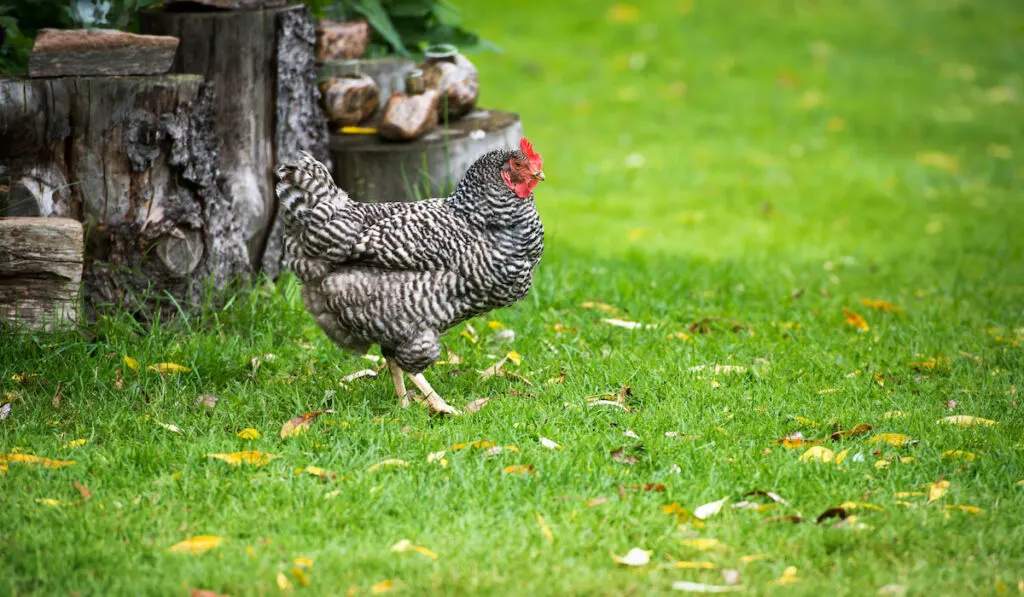
Plymouth Rock – Family Pet
Because of their gentle, kind nature, Plymouth Rocks make excellent homestead pets.
These birds get along well with humans and other creatures. They’ll stick close to their pack members if given a chance.
Regarding safety around kids, Plymouth Rock chickens are among the best breeds. Even the roosters are pleasant and peaceful.
Plymouth Rocks are not afraid to be picked up or petted and are content while in the arms of their owners.
These birds get along great with other pets, and it’s not uncommon for them to become friends with a cat or dog.
Health and Care
The Plymouth Rock is a hardy and resilient breed. Due to their sturdy genes, these birds can potentially live for up to 12 years with the right care.
Except for common parasites, they are not troubled by any specific illnesses. Parasites, both internal and external, require regular treatment.
You can also boost your chicks’ immune systems by giving them vaccines or medicated chick starters.
The most important thing you can do is ensure they have access to nutritious food and plenty of water.
This is particularly necessary if you want high-quality eggs from your hens.
Also, make sure they have a safe place to live. The coop and the outside area where the chickens roam should be kept clean and clear of any accumulated dung or dirty bedding at all times.
Plymouth Rocks thrive in a range of conditions.
However, roosters may require extra care in very cold weather because they have huge combs and wattles.
Roosters might benefit from applying petroleum jelly to their combs in areas where there is frost or very cold weather.
Aside from that, your Plymouth Rock chicken should be able to handle practically everything.
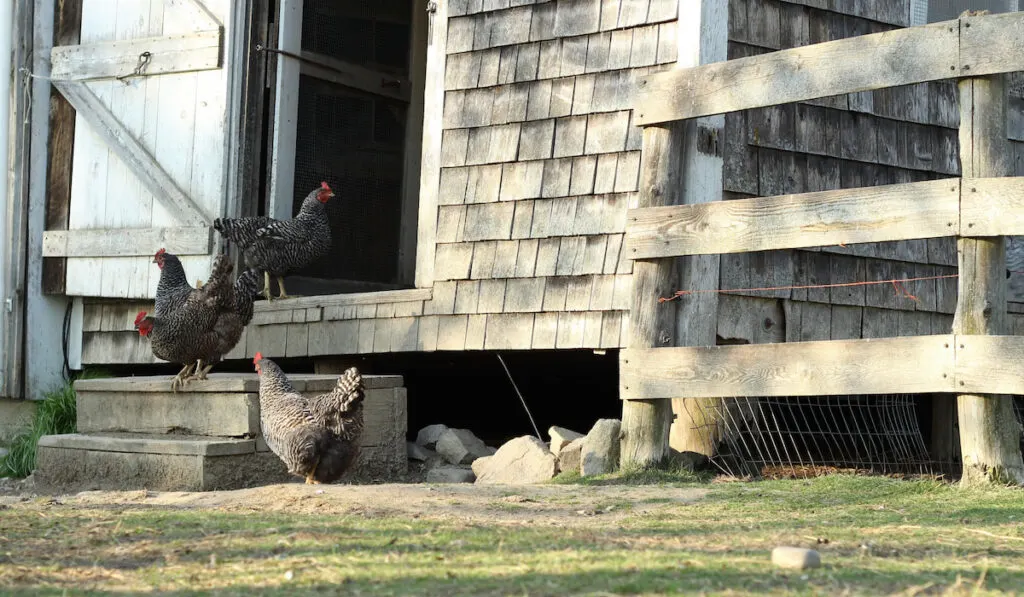
Temperament
Because of their kind demeanor, these chickens are widely kept in backyard coops.
Once they get to know you, these birds will trust you completely, making them great pets for families with young children.
They will stay close to you and cluck at you all the time. They also enjoy sitting in your lap, especially when they are handled regularly as chicks.
Plymouth Rocks are generally peaceful and avoid conflict at all costs when it comes to their flock buddies.
They tend to fall somewhere in the center of the pecking order in most flocks.
They also have a certain quirky, silly charm that makes them entertaining to observe.
On the other hand, they are not particularly smart and have trouble determining when a threat might occur. If you do let them roam free, you should make sure they are safe from predators.
Overall, Plymouth Rock chickens are great for families with young kids and people who have never kept chickens before.
Plymouth Rock Chicken Broodiness
It might take a while for a Plymouth Rock hen to get broody and start sitting on eggs. When they do become broody, they do a fantastic job of caring for their young.
You can buy an incubator if you want to hatch fertilized Plymouth Rock chicken eggs on your own. Since hens that are broody stop laying eggs, this helps keep egg production up.
If your hen does get broody and hatch a nest of eggs, you won’t have to worry about her chicks because she will be a wonderful mother.
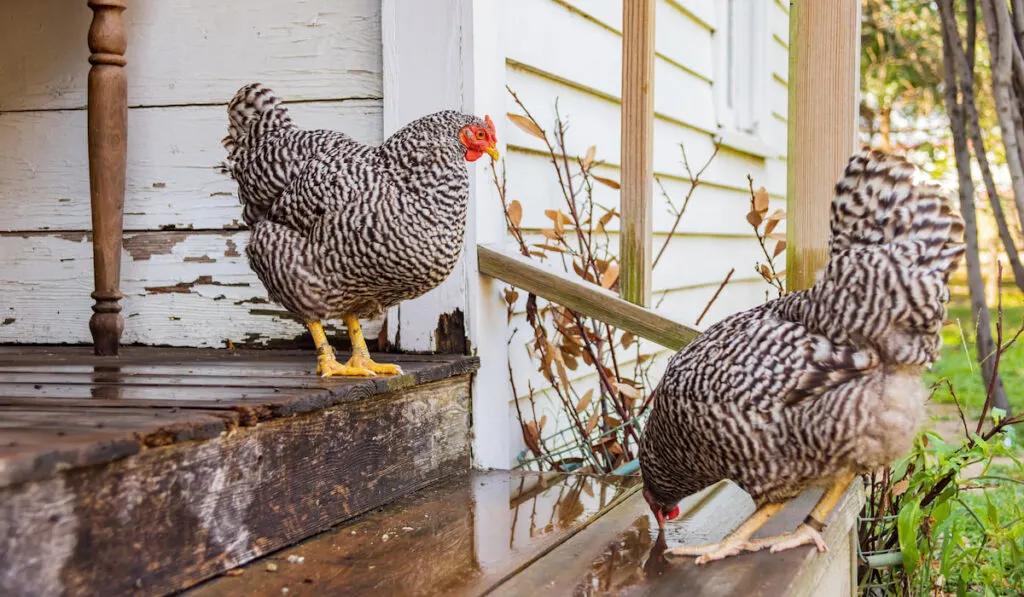
3 Ways of Chick-Sexing
Plymouth Rock chickens can be sexed with 80% accuracy at hatching, which is useful whether you want to grow males as meat birds or choose hens for egg production.
- The Head Spot – Plymouth Rock male chicks will have a prominent white spot on their heads, while females will have a much smaller white spot.
- Feathers Coloration – Feathers on one-week-old chicks reveal their sex: females are darker, while males are much lighter in hue.
- The Leg and Feet’ Skin Color – This is a 95% accurate way to figure out the chick’s sex. And the idea is the same as with the feathers’ colors. Females will have darker skin on their legs and feet, while males will be much lighter in color.

How Loud Is the Plymouth Rock Chicken?
The Plymouth Rock is typically a placid and quiet bird. They can be heard talking calmly to each other, but they aren’t known for loud temper tantrums or anxiety attacks.
Generally quiet, they are a good choice for a neighborhood or a small farm in the backyard.
As long as they stay away from the fence lines, they probably won’t bother the neighbors too much.
Final Thoughts
The Plymouth Rock chicken is a fantastic choice for a backyard flock since it adapts well to both enclosed and free-range conditions, doesn’t need any particular care, and is active and friendly.
Because they reach a respectable size and weight, in addition to having an outstanding capacity for egg production, they also make wonderful meat birds.
This chicken ticks all the boxes!
Resources
- https://livestockconservancy.org/heritage-breeds/heritage-breeds-list/plymouth-rock-chicken/
- https://milefour.com/blogs/learn/plymouth-rock-chickens
- https://www.chickensandmore.com/plymouth-rock-chicken/#Plymouth_Rock_Breed_History
- http://www.hobbymommycreations.ca/2016/05/sexing-barred-plymouth-rock-chicks.html
- https://domesticanimalbreeds.com/plymouth-rock-chicken-breed-everything-you-need-to-know/
- https://www.purelypoultry.com/barred-plymouth-rock-chickens-p-881.html
- https://homesteadsweethome.com/plymouth-rock-chickens/
